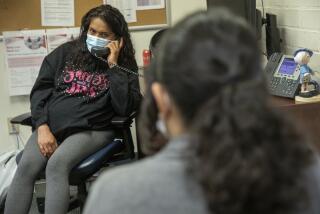Lack of enrollment workers hampers insurance exchange sign-ups
- Share via
A month into enrollment under the Affordable Care Act, hundreds of healthcare workers and insurance agents are still unable to sign up consumers for health coverage through California’s new exchange.
Despite promises of an army of workers blanketing the state to help, many aren’t in place — or they’re hitting one state roadblock or another.
Critics say training sessions started late, background checks have taken too long and some people are suffering computer log-in problems. Backers of the healthcare expansion worry that these ongoing delays will hurt enrollment efforts with just six weeks left for people to get coverage effective Jan. 1.
Covered California, the state insurance exchange, acknowledges that there have been problems. But it says it is moving swiftly to have enough enrollment help by mid-November when sign-ups are expected to accelerate.
But patience seems to be wearing thin, and complaints are growing.
“The process is simply taking too long,” said Carmela Castellano-Garcia, chief executive of the California Primary Care Assn., which represents community health centers with enrollment workers. “Our folks are frustrated with onerous delays at every step. We could be enrolling more people.”
Consumers can get coverage directly by contacting Covered California’s call centers or clicking on the state’s website, which has worked better than the federal government’s error-ridden healthcare.gov site.
But by their own estimates, state officials say about 80% of consumers will want in-person help to sort through their new insurance options under a complex law.
To meet that demand, the state envisioned having 16,000 enrollment counselors and thousands more insurance agents assisting consumers and submitting their applications electronically.
Millions of Californians, depending on their income, will qualify for subsidized private health insurance or an expansion of Medi-Cal, the state’s Medicaid program for the poor.
But fewer than 20% of the enrollment counselors and insurance agents who have started the state’s training process have been authorized to handle applications.
These snags have forced clinic workers and agents to ask some potential applicants to come back later or to resort to paper applications. People eligible for Medi-Cal can be transferred to county workers who can handle enrollment.
“We know there have been issues in enrolling people and we are moving as quickly as we can to address them,” said exchange spokeswoman Anne Gonzales.
“Enrollment counselors and agents are an important component to enrollment because we can’t do this on our own,” she added. “We are asking counselors to make future appointments and to use paper applications when they can’t access the website.”
It’s hard to gauge the extent of this problem since California won’t divulge enrollment figures until Nov. 14.
The state has said that 179,562 insurance applications have been started through Oct. 26. Open enrollment lasts until March 31, but consumers must act by Dec. 15 if they want coverage starting Jan. 1.
California is trying to enroll up to 1.2 million people in subsidized health plans by the end of next year and an additional 1 million people in Medi-Cal.
The state acknowledged this week that it has a long way to go in approving enough field workers. In all, the state said, 619 of 4,213 enrollment counselors have been certified and authorized to enroll people. Among insurance agents, 3,143 of nearly 16,000 have completed state training.
Helena Ruffin, a health insurance agent in Venice, said she got through the entire state training process shortly after enrollment began Oct. 1. She even put Covered California’s logo on her car to promote the exchange.
Then frustration set in because she can’t get her agent log-in to work for the state’s enrollment system. “We can’t enroll anybody, and I have a list of customers who are ready,” Ruffin said.
Several community health centers in the Los Angeles area have reported similar problems.
At St. John’s Well Child & Family Center, half of its 12 enrollment counselors have completed state training. But none of them have their state identification numbers in order to log in and sign up people for coverage, said clinic manager Jonathan Mejia. The health center is compiling a list of families to check back with.
Judi Rose, chief development officer at the Valley Community Clinic in North Hollywood, said none of her clinic’s 14 enrollers had finished the state’s training process yet.
“There is interest” among patients, Rose said. “It’s a hardship that we can’t enroll people at this time.”
Clinic officials say Covered California has taken several steps recently aimed at speeding up the process. They say the state made fingerprinting more convenient, particularly for rural enrollment workers, and it has expanded the opportunities for training.
Micah Weinberg, a senior policy advisor at the Bay Area Council, an employer-backed nonprofit group in San Francisco, said the state should make it a top priority to fix these problems.
“I know the exchange has a lot on its plate right now,” he said. “But it’s really frustrating this hasn’t been resolved by now.”
Twitter: @chadterhune
@laterynbrown
More to Read
Inside the business of entertainment
The Wide Shot brings you news, analysis and insights on everything from streaming wars to production — and what it all means for the future.
You may occasionally receive promotional content from the Los Angeles Times.












